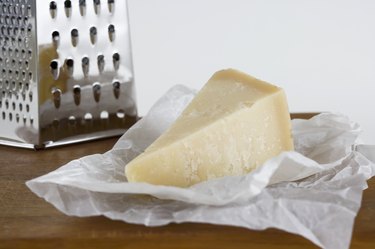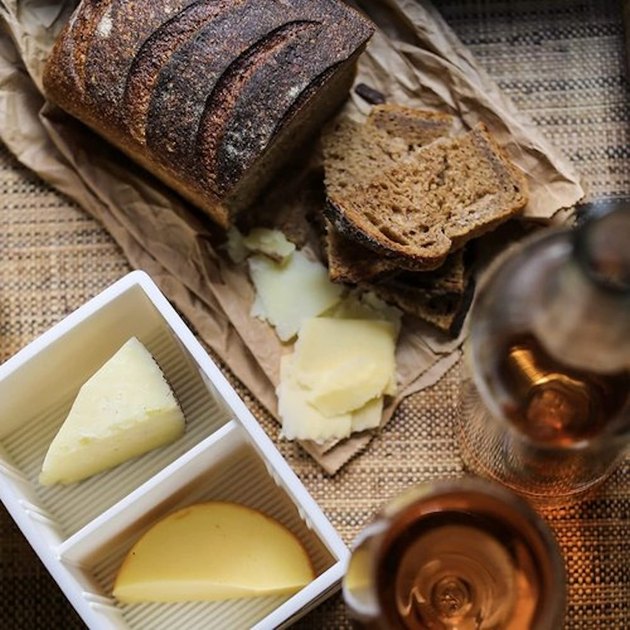
Milk is a valuable food source, with its rich mixture of protein, vitamins and minerals, but it's highly perishable. That's why we've come up with so many ways to preserve it, including yogurt, kefir and especially cheese. Cheese lasts longer than most other dairy products, but most of us know from experience that it can quickly become moldy in the fridge. If you're a cheese lover that's disappointing (and expensive!), so it's worth taking a few minutes to learn how to store cheese properly. To get you started, we've got six of the best ways to store cheese along with a few tips to help you get the best storage life from your cheeses.
Storing Cheese (It's Complicated)
Video of the Day
Real cheese—not the gummy processed kind—is one of the most complex foods we commonly eat. It starts with milk, a substance containing lots of protein, sugars and acidity; but the end product depends just as much on the intricate interactions of the milk's components with enzymes, bacteria, and often molds. The molds and bacteria that give cheese its character are living organisms, which is what makes individual cheeses so distinct from each other. It also means that the wedge you just bought from your favorite store is a full-blown ecosystem in its own right, one that will either flourish or die under your care (no pressure!).
Video of the Day
The ideal storage scenario for most cheeses is a cool, very humid location that still provides a bit of airflow. Historically that might mean a stone cellar or even a cave, but those aren't options most of us have available. In modern homes the best bet is the refrigerator, but it's both colder and drier than cheeses would ideally prefer. Designating a crisper drawer for your cheese will help, because those are warmer and more humid than the main fridge, but how you wrap the cheese is still important. You want to allow a bit of airflow, so the cheese can breathe (that's not a metaphor; remember those living organisms?) but still protect it from drying out. The best cheese wrapping products walk that fine line, with varying degrees of success.

What to Consider When Purchasing Cheese Storage Products
Your Usage: How much cheese do you buy, and what kind of cheese buyer are you? Are you the person who buys a big block of plain ol' cheddar and whittles away at it for weeks? The one who has two dozen small wedges jumbled together in the fridge? The one who's got a dedicated cheese fridge, and buys cheeses specifically for aging (okay, that person probably isn't reading this article)? While the same broad rules apply to cheese storage in general, your priorities and your choice of storage options will vary depending on the answers to those questions.
Sustainability: Plastic wrap is a pretty non-sustainable option, and in fact it's not even recyclable. Aluminum foil can be recycled, as long as it's clean and there's a program in your area. Some other materials are biodegradable, whether they go to your green bin or straight to the landfill. It won't necessarily be the top criterion for a lot of people, but it's something to take into account.
Cost: While most authorities agree that plastic wrap isn't a good option for wrapping cheese, it has the virtue of being inexpensive and readily available. Most of the alternatives cost more, and in some cases a lot more. If you're a serious cheese aficionado you can make a case for a long-lasting permanent option, while casual diners might draw the line at a much lower price level. It's all down to your budget, and how serious you are about your cheese.

1. Cheese Paper
Purpose-made cheese paper is usually the best option for wrapping your wedges and blocks of cheese. "Classic" cheese paper consists of two layers laminated together: An inner layer of paper—which is permeable to air and blots up any excess moisture or oil—and an outer layer of plastic. The plastic retains moisture, but is pierced with thousands of micro-perforations to allow air to escape. It's a good product, and there are several brands on the market, but they aren't biodegradable and can't be recycled.
These sheets of cheese paper from Ovtene take a completely different tack. They're made primarily of calcium carbonate (the same stuff that makes up most of an egg's shell) with a plastic binder. They contain less than half the plastic of conventional cheese paper, they're 100 percent recyclable, and the company boasts that no water or trees are used in their manufacture. Those are all positives, but a more immediate consideration is that the sheets work really, really well to preserve your cheese. You can expect to double or triple your cheese's storage life, and afterwards you can simply hand wash them in warm, soapy water and reuse them. Each package contains 10 large sheets (20 by 14 inches) and 10 small sheets (10 by 14 inches), so overall it's an excellent value.
2. Wax Paper
Wax paper was popular for many years as a general-purpose food wrap, until it was shouldered aside by plastic film and zipper-seal bags. It still has its virtues and one of them is that it's pretty good at protecting cheese. Because it's paper, it still allows the cheese to breathe, but because it's permeated with a food-grade wax it also provides pretty good protection against drying out.
While ordinary department-store wax paper will do the job, Formaticum's "Zero" cheese paper does it better. This is a heavier-duty wax paper made specifically for cheese storage (Formaticum is a pioneer and a titan in this product category) that offers better protection and longer life for your cheeses. It's also made of pulp from certified-sustainable forests, and is highly biodegradable. Just wrap your cheese carefully in a sheet of the paper, label and seal it with one of the supplied labels, and pop it into your fridge.
With any form of wax paper or parchment paper, you'll enhance your protection by putting the wrapped cheese inside a loose plastic outer covering. This could be an airtight storage container, a bag with plenty of air left inside, or—best of all—the kind of semi-permeable plastic bags meant specifically for food storage.
3. Beeswax Food Wraps
Functional cheese wrappers don't necessarily need to be made for the purpose. The environmentally-friendly beeswax food wraps that have become popular in recent years work reasonably well as cheese wraps, too. They're typically made of an all-natural fabric, such as cotton, that's been impregnated with beeswax and (sometimes) other natural-source waxes or resins. These ones, from the Trifecta Living Company, are a good example.
The pack of seven contains two smaller 7- by 8-inch wraps, three medium 10- by 11-inch wraps, and two large 13- by 14- inch wraps, which would accommodate several blocks of cheese in different sizes. They're visually appealing as well, coming in several bright patterns the company designs in-house. The wax-coated wraps don't breathe as much as proper cheese paper, so you'll need to fold them loosely around your wedges so there's just a bit of air exchange through the folds.
4. Parchment Paper
If you want to upgrade your cheese-keeping game but would rather not clutter your kitchen with a single-purpose wrapping option, you can get good results with a something most of us already keep around: Parchment paper. Although it won't protect your cheese quite as well as actual cheese paper, it makes a good alternative for cheeses you'll be using up within a couple of weeks. Parchment is readily available in either sheets or rolls, but we like pre-cut sheets for wrapping cheese. They give you a consistent size and shape, and it's easier for you to sharpen your wrapping skills if the paper stays the same each time.
These unbleached SmarTake sheets are a good value and not too heavy-gauge for easy wrapping, and the 12- by 16-inch sheets are large enough for a big block of cheese (or you can halve them for smaller pieces). Also, their plain brown color helps block light from reaching your cheese. That in turn will help prolong its shelf life.
5. A Cheese Vault
Keeping cheese in its own dedicated storage box is a good alternative to wrapping it. A sealed container creates its own microclimate, giving the cheese room to breathe while still protecting it from drying out in your refrigerator. The simplest cheese vaults are little more than plastic containers with some form of controlled airflow, but this one from Capabunga is a little more deluxe. Created by veterans of the wine industry—because wine and cheese go together like, well, wine and cheese—it's made of naturally BPA-free silicone, rather than hard plastic. The floor and lid of the box are both designed to divert any excess moisture away from your cheese, and the lid gives you a snug but not airtight fit so your cheese can breathe but remain protected.
Because it's silicone, you can write on it with a regular pen, to label your cheeses, and then wash away the ink when you clean it between uses. You can use the box as a single compartment, or use the supplied divider to keep smaller pieces of two separate cheeses. The only downside to this unit is its compact size, which makes it better suited to small cuts of artisanal cheese than big slabs of the supermarket product.
6. A Cheese Grotto
If you're a serious aficionado, the ultimate in small-scale cheese storage is a Cheese Grotto, from the company of the same name. You could think of it as a scaled-up cheese vault, or a scaled-down cellar, or the cheese-lover's equivalent of a cigar-lover's humidor, and all of those things are correct. The secret sauce here is a terra-cotta brick that's soaked in water, and placed in the bottom of the grotto. Water evaporates slowly from the porous block, maintaining a high level of cheese-friendly humidity in the atmosphere without allowing any mold-promoting moisture to accumulate on the cheese inside. The vaulted ceiling of the box prevents any condensation from falling on your cheese, for the same reason.
Grottos are available with and without a hygrometer, to let you monitor and log the humidity levels, and we've chosen to include it. You can store entire cheeses inside the grotto, depending which size you buy (our pick here is the fridge-friendly small, or "mezzo" size), or use the provided divider to separate two different cheeses. You can use this on your counter for cheeses you'll consume within days, or keep it in the fridge for storage that lasts weeks. You'll need a smidge of patience, though, because each grotto is hand-built to order.
Best Storage Methods for Different Cheeses
Choosing the best cheese storage products is only half of the battle. To complicate things further, different kinds of cheese have different storage requirements. Broadly speaking:
- Soft, fresh cheeses (queso fresco, quark and ricotta) usually come in plastic tubs, and can be stored in them until they're used or pass their recommended use-by dates. They're an exception to the "need to breathe" rule, because they're consumed when fresh-made and don't depend on the various microorganisms to give them a distinct flavor.
- Brined cheeses (feta, fresh mozzarella or bocconcini) are usually packaged and sold in their brine. Keep them in the original package and brine for short-term storage. If the brine starts to smell funky, rinse the cheese and dissolve a tablespoon or so of kosher or pickling salt in a cup of water to make a new brine. Put the cheese and brine in a clean plastic container, and return it to your fridge.
- Rind-ripened
cheeses (Brie or Camembert) are ripened by the bloom of white mold on
their rinds. Give them a breathable wrapper, or store them in a rigid container where they won't be squashed. If you have other
cheeses in the same storage area, you'll need to also put your wedge and
its breathable wrapping inside another loose but airtight wrapping, to
keep the mold from making all of your other cheeses fuzzy and white.
- Blue cheeses (Roquefort, Stilton and Gorgonzola) are often soft or crumbly in texture, and may stick to your wrapper. Cheese paper is still a good choice, but a rigid container (aka, a cheese vault) is a good option to protect them in your refrigerator. A container, or an airtight second wrapper, can also keep the blue cheese's bold flavor from infusing into milder cheeses nearby, and—as with rind-ripened cheeses—keep its molds from going where they're not wanted.
- Firm cheeses (Cheddar, Gouda and Monterey Jack) store well when wrapped closely in cheese paper or one of the other wrappers mentioned.
- Hard cheeses (Parmigiano-Reggiano, Asiago and Dry Jack) can be kept almost indefinitely in the refrigerator in cheese paper. Because they're already dry and hard they don't need to breathe much, and can be kept successfully even in plastic wrap. Well-aged examples can keep at room temperature for weeks when wrapped in cheese paper.





